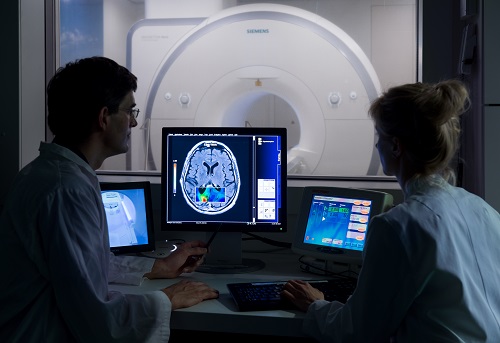06/03/2017
Print PagePhysicists simplify production of hypersensitive contrast agent for cancer diagnostics

“With this process we have named SAMBADENA we are able to make the contrast agent for hyperpolarization MRIs much cheaper, simpler and faster than previously possible,” said the project leader Dr. Jan-Bernd Hövener, Emmy Noether research group leader in the Radiology-Medical Physics clinic of the University Hospital Freiburg. Along with his doctorate students Andreas Schmidt and Stephan Berner, he has achieved an important step in the production of hyperpolarized contrast agents. “For the first time it is possible to produce the injection solution with the contrast agent right where it is needed, in the MRI scanner, within a matter of seconds,” says principal author Andreas Schmidt.
With the hyperpolarization MRI, a magnetically marked contrast agent is injected into the body, from where it sends out signals which are significantly stronger than would be possible in a classic MRI. This can greatly increase the sensitivity of the MRI, and thus help gather information crucial for diagnosis and therapy. Previously, liquid hyperpolarized contrast agents were chiefly produced with dynamic nuclear polarization (DNP). For this method, already used on patients, scientists require a complex device that costs up to 2.5 million Euros. The new method opens up the opportunity to drastically decrease these costs. “We hope that this will help further develop the use of hyperpolarization MRI,” says Jan-Bernd Hövener, who researches in the radiotherapy and imaging department of the German Cancer Consortium, and is part of the EU sponsored research network EUROPOL-ITN.
By creating the contrast agent directly in the MRI device, researchers will soon presumably be able to use molecules as contrast agents, whose marking would otherwise have disintegrated during transportation to the MRI device. “We are now intensively working on using SAMBADENA on bio molecules which naturally occur in the body. Their deconstruction or reconstruction could then be observed in real time,” says Jan-Bernd Hövener. Early unpublished results point in this direction. Since cancer cells often exhibit a different metabolism, an increased or decreased deconstruction of the contrast agent could point to cancer tissue. This would allow for early identification of metastases and the ability to characterize tumors more accurately. It also seems possible to use the change in cancer metabolism to detect earlier whether a therapy is working or not. “A further advantage is that endogenous substances do not cause allergic reactions, which is sometimes the case with previous MRI contrast agents,” says Jan-Bernd Hövener. A series of suitable contrast agents are to be developed in subsequent studies.
Schmidt, A.B. et. al.: Liquid-state carbon-13 hyperpolarization generated in an MRI system for fast imaging. In: Nature Communications (06. März 2017) doi:10.1038/ncomms14535
Images and a video for press releases are available for download at:
https://www.youtube.com/watch?v=N2Ekdk09fl4